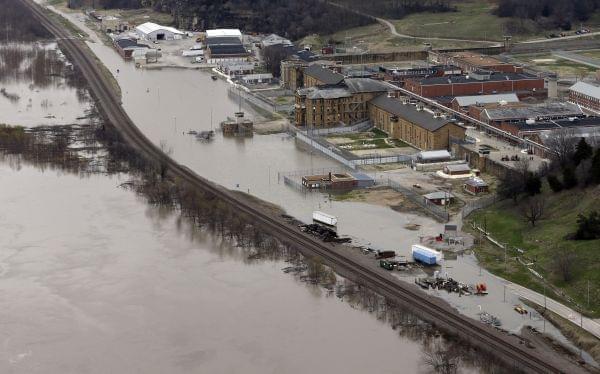Flooding Prompts Evacuation In Portion Of Southern Illinois

In this aerial photo, floodwater from the Mississippi River threatens the maximum security Menard Correctional Center, Thursday, Dec. 31, 2015, in Chester, Ill. Surging Midwestern rivers forced hundreds of evacuations, threatened dozens of levees and brought transportation by car, boat or train to a virtual standstill Thursday in the St. Louis area. Jeff Roberson/Associated Press
Authorities in southern Illinois are urging residents living behind the Len Small levee to move to higher ground after Mississippi River water topped it. The levee in the far southwestern tip of Illinois protects the towns of Olive Branch, Hodges Park, Unity and rural homes. All told, about 500 people live behind the levee.
Alexander County Board Chairman Chalen Tatum says the river is expected to rise another foot and a half before cresting Sunday, so flooding is expected to get much worse. He issued what he called an emergency evacuation order Friday.
The county is also urging residents in and near East Cape Girardeau, Illinois, to evacuate. The move is precautionary: A levee there is holding for now but a record crest is predicted.
Gov. Bruce Rauner has ordered Illinois National Guard soldiers to active duty to help with flood recovery efforts in the state. In a statement on Friday, Rauner says the step means soldiers will be ready at a moment's notice for local communities as flood waters could continue to rise over the weekend. About 20 soldiers were ordered to report to the guard's Marion Readiness Center.
Rauner's Friday schedule included stops in six Southern Illinois communities affecting by flooding, including stops in Alton, Grafton, and Prairie du Rocher in Randolph County. His six stops on Saturday include Cairo and Olive Branch.
On Friday, authorities in central Illinois found the body of one of two missing teenagers whose pickup truck had been pulled from floodwaters. The two 18-year-olds were reported missing on Monday. Divers were concentrating search efforts in flooded areas where one of the teen's cellphone was tracked. On Friday morning, Devan R. Everett was found in the water near where dive crews found the truck.
In East Central Illinois, Douglas County was named a state disaster area on Wednesday, bringing the total receiving a state declaration to 12. In response, local damage assessment teams are reviewing the impact of the flood waters on homes and businesses.
The declaration paves the way for local authorities to obtain state resources like sandbags and water pumps.
Illinois Emergency Management Agency spokesperson Patti Thompson says that in response to the disaster declaration, counties are doing their initial review of how high the floodwaters got in Villa Grove and other towns.
That gives us a better idea how severe the damage was – and also helps quantify the amount of damage that there is, too, and I don’t mean by dollar amount, but the number of homes and businesses that were affected," she said. "And they’ll also be looking at the local governments there too, as far as any kind of property damage.”
Thompson says a ‘variety of thresholds’ still need to be met before determining if Douglas and other counties also qualify for federal disaster aid. The state will have to show that local and county governments have racked up a certain level of costs in responding to the flooding. The minimum amount is $18.1 million for city and village governments across Illinois.
Thompson says flooding is still a life safety issue in much of Illinois, making it hard to complete damage assessments.
